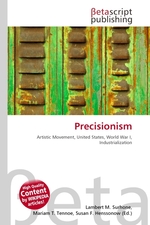Precisionism
Lambert M. Surhone, Miriam T. Timpledon, Susan F. Marseken
бумажная книга
High Quality Content by WIKIPEDIA articles! Precisionism, also known as Cubist Realism,was an artistic movement that emerged in the United States after World War I and was at its height during the inter-War period. The term itself was first coined in the early 1920s. Influenced strongly by Cubism and Futurism, its main themes included industrialization and the modernization of the American landscape, which were depicted in precise, sharply defined, geometrical forms. The themes originated from the streamlined architecture and machinery of the early 1900s. Precision artists considered themselves strictly American and tried to avoid European artistic influences. There is a degree of reverence for the industrial age in the movement, but social commentary was not fundamental to the style. The degree of abstraction in the movement ranged considerably from Charles Demuth's famous I Saw the Figure 5 in Gold from 1928; to Charles Sheeler's work that sometimes verged on the photorealistic. In addition to his paintings Charles Sheeler also created photographs of factories and industrial buildings as did his friend the photographer Paul Strand.
Данное издание не является оригинальным. Книга печатается по технологии принт-он-деманд после получения заказа.


